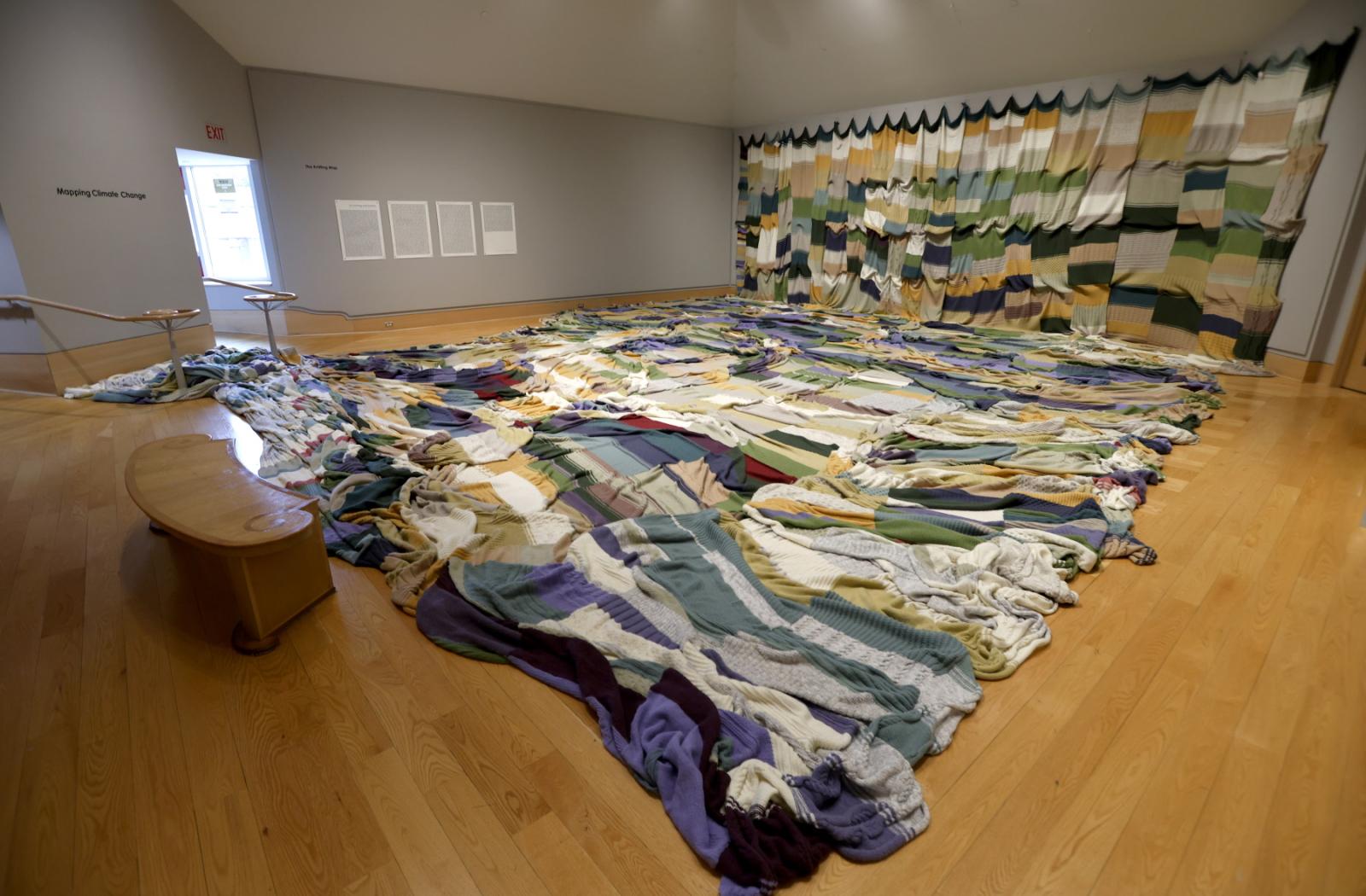It took “over 2,500 volunteer hand-knitters over 365 days,” reads the plaque to The Knitting Map, a new exhibit at Lawrence University’s Wriston Art Center.
The tapestry, a warning of the ensuing climate crisis, was co-created in 2005 by multimedia artist Jools Gilson and cultural producer Richard Povall. The work, which fills an entire wall and the floor of Wriston’s Kohler Gallery, is on display alongside The Tempestry Project, a smaller and more recent work with the same climate focus. Both pieces constitute the Mapping Climate Change exhibition, on loan from the Berman Museum of Art in Collegeville, Pennsylvania. It opened in Wriston Sept. 22 and continues until Nov. 17.

Mapping Climate Change incorporates two separate displays.
Gilson is on campus Oct. 16-20 as part of a five-day residency, joined by Deborah Barkun, the exhibit curator and creative director of the Berman Museum of Art.
At 4:30 p.m. Oct. 17, Gilson will lead a climate change discussion panel in the Wriston Auditorium. And at noon Oct. 19, she will lead a tour of The Knitting Map. Later that day, Gilson is hosting an Open Movement workshop from 4 to 6 p.m. in Warch Campus Center's Esch Hurvis Studio.
The art project originated in Gilson’s hometown of Cork, Ireland, in the early 2000s when climate change was often absent from public consciousness. Its appeal lay in its premise that hundreds of local knitters would be involved. However, this premise also brought its most significant challenge: climate change was an unfamiliar topic at the time. In addition, the lens of contemporary art was often thought to be inaccessible.
Hone your creative identity through hands-on technical instruction and articulate artistic concepts while also gaining the critical perspectives of a liberal arts education.
To counter these hurdles, Gilson held performances in random public spaces—city streets, buses, civic buildings, and art galleries. She advertised the project via knitting-based games, dances, and storytelling. In one case, she drove around Cork on a motorcycle, all while actively knitting the clothing she wore. The gallery includes a small TV that features many of these impromptu performances on repeat.
By the end of 2005, more than 2,000 people had contributed to the project. It became a tourist attraction, and visitors often contributed a small portion. Four massive exhibit plaques feature every name involved.
The most prolific volunteers were working-class women, in their 50s or older. They had space in the crypt of St. Luke’s Church reserved for the task.
Learn about exhibits in the Leech, Hoffmaster, and Kohler galleries.
Textile became the medium through which the climate data was translated; inevitably interpreted through the personal calligraphy of makers’ stitches, as described by the exhibit’s creators. "The process of hand-knitting and the resultant textiles map the motions of makers’ hands, as much as they transmit data relating to climate and locale. These projects integrate science and art, technology and handwork, and authorship and collaboration to visualize a developing public consciousness of environmental justice issues."
Gilson’s fruitful partnership with Povall was key in developing the tapestry’s accompanying ideology. Povall was eager to assemble copious amounts of data to give the project an air of scientific legitimacy. He analyzed weather reports via a local weather station and produced a systematic design plan. The result was a large color-based chart, which was eventually translated to a tapestry.
The tapestry's physical presence is truly remarkable, commanding the observer's entire field of vision with resounding prominence. There is a deliberate use of earthy tones, as lush greens evoke the world's forests, while deep blues recall the oceans. The full spectrum of the Earth's geographic diversity is on display, with a range of hues including khaki, brown, yellow, and turquoise.
Although there are no specific locations included, the tapestry is indeed a map. Aside from its mapping of Cork’s weather data collected by Povall, it is a temporal map as well. It profoundly illustrates the Earth’s diverse beauty and reminds us of what we stand to lose if we ignore it.
The Knitting Map has toured the world since it was first commissioned by the European Capital of Culture in Cork 20 years ago.



